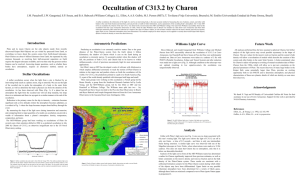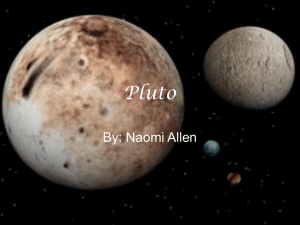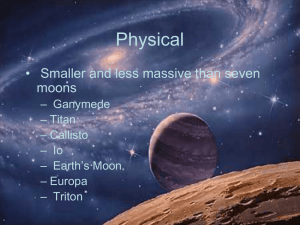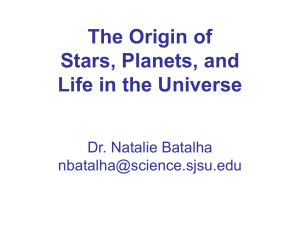Pasachoff, planethunters blog 2 - Astronomy
advertisement
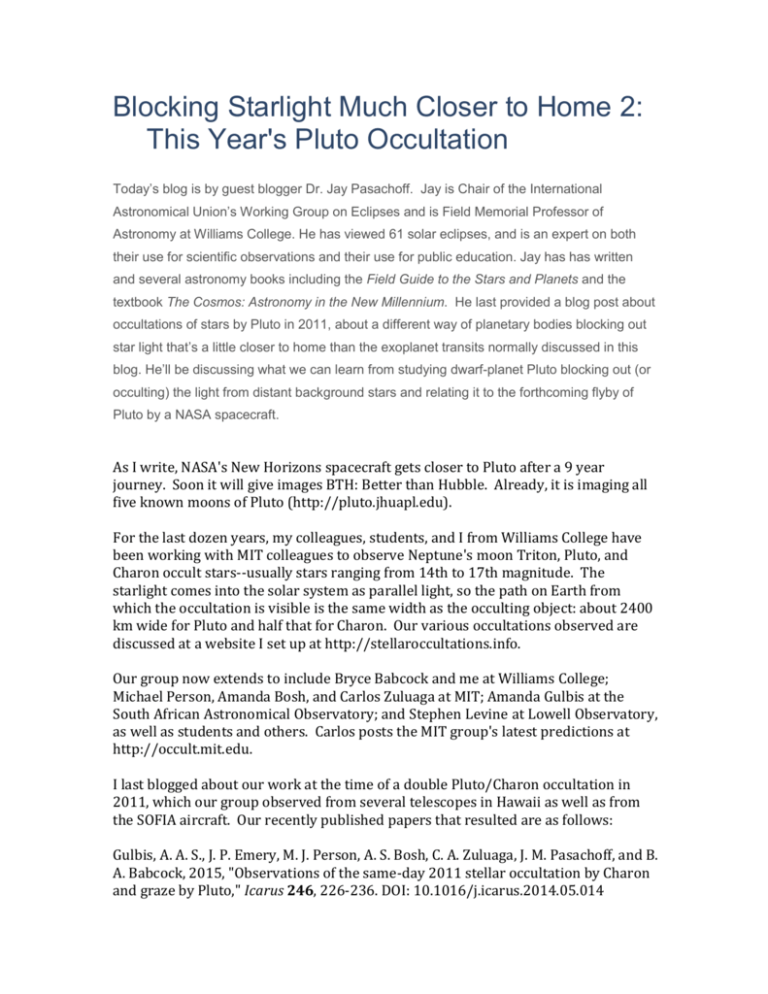
Blocking Starlight Much Closer to Home 2: This Year's Pluto Occultation Today’s blog is by guest blogger Dr. Jay Pasachoff. Jay is Chair of the International Astronomical Union’s Working Group on Eclipses and is Field Memorial Professor of Astronomy at Williams College. He has viewed 61 solar eclipses, and is an expert on both their use for scientific observations and their use for public education. Jay has has written and several astronomy books including the Field Guide to the Stars and Planets and the textbook The Cosmos: Astronomy in the New Millennium. He last provided a blog post about occultations of stars by Pluto in 2011, about a different way of planetary bodies blocking out star light that’s a little closer to home than the exoplanet transits normally discussed in this blog. He’ll be discussing what we can learn from studying dwarf-planet Pluto blocking out (or occulting) the light from distant background stars and relating it to the forthcoming flyby of Pluto by a NASA spacecraft. As I write, NASA's New Horizons spacecraft gets closer to Pluto after a 9 year journey. Soon it will give images BTH: Better than Hubble. Already, it is imaging all five known moons of Pluto (http://pluto.jhuapl.edu). For the last dozen years, my colleagues, students, and I from Williams College have been working with MIT colleagues to observe Neptune's moon Triton, Pluto, and Charon occult stars--usually stars ranging from 14th to 17th magnitude. The starlight comes into the solar system as parallel light, so the path on Earth from which the occultation is visible is the same width as the occulting object: about 2400 km wide for Pluto and half that for Charon. Our various occultations observed are discussed at a website I set up at http://stellaroccultations.info. Our group now extends to include Bryce Babcock and me at Williams College; Michael Person, Amanda Bosh, and Carlos Zuluaga at MIT; Amanda Gulbis at the South African Astronomical Observatory; and Stephen Levine at Lowell Observatory, as well as students and others. Carlos posts the MIT group's latest predictions at http://occult.mit.edu. I last blogged about our work at the time of a double Pluto/Charon occultation in 2011, which our group observed from several telescopes in Hawaii as well as from the SOFIA aircraft. Our recently published papers that resulted are as follows: Gulbis, A. A. S., J. P. Emery, M. J. Person, A. S. Bosh, C. A. Zuluaga, J. M. Pasachoff, and B. A. Babcock, 2015, "Observations of the same-day 2011 stellar occultation by Charon and graze by Pluto," Icarus 246, 226-236. DOI: 10.1016/j.icarus.2014.05.014 Bosh, A. S., M. J. Person, S. E. Levine, C. A. Zuluaga, A. M. Zangari, A. A. S. Gulbis, G. Schaefer, E. W. Dunham, B. A. Babcock, A. B. Davis, J. M. Pasachoff, P. Rojo, E. Servajean, F. Förster, T. Oswalt, D. Batcheldor, D. Bell, P. Bird, D. Fey, T. Fulwider, E. Geisert, D. Hastings, C. Keuhler, T. Mizusawa, P. Solenski, B. Watson, 2015, "The State of Pluto's Atmosphere in 2013," Icarus 246, 237-246. http://dx.doi.org/10.1016/j.icarus.2014.03.048 For the ten minutes or so nearest to the occultation for ground-based telescopes, the object and the star appear merged, and we detect the occultation by the light curve. For Charon, with no atmosphere (and our occultation method is very sensitive), the starlight disappears abruptly. If the star is brighter than the occulting object, the occultation is quite noticeable; if the star is fainter, then just a percentage is subtracted from the total. For Pluto (and, earlier, for Triton), its atmosphere bends and distorts the starlight, and the ingress and egress are slanted on the light curve. These ingresses and egresses can last a minute or so with a central occultation of five minutes or so, depending on the relative speed of Pluto with respect to the star. Astronomical circumstances currently put most of the occultations visible mainly in the southern hemisphere. Last year, in late July 2014, my student Adam Schiff '15 (Keck Northeast Astronomy Consortium, from Middlebury College), Robert Lucas from Sydney, and I observed from the Mt. John University Observatory of Canterbury University, New Zealand. The observatory is about a 3-hour drive west of Christchurch. We were helped especially by the observatory's superintendent, Alan Gilmore. Even though the UCAC star catalogue's values of 15th magnitude for the occulted stars were high by about two magnitudes, we succeeded in observing two occultations by Pluto out of the three we tried. While we were there, we had heard from Wes Fraser of the Herzberg Institute of Astrophysics, Canada (who I knew from when we were both in Mike Brown's group at Caltech a few years ago) about a prospective occultation by the KBO Quaoar, and also from NZ occultation coordinator David Herald about a prospective occultation by Pluto's tiny moon Nix; we have flat light curves for both of them--that is, no occultation shadow passed over our site. One needs a dense picket fence of telescopes plus a lot of luck to capture occultations of such small objects. While we were there, we had coordinated observations from Amanda Gulbis with the 4-m telescope on Siding Spring, Australia, and with David Osip on the 6.5-m Clay, Stephen Levine on the 4.1m SOAR, and Mike Person on the 2.5-m DuPont telescopes in Chile but they, unfortunately, had clouds for the most part. After our observing run was over in New Zealand, there was another event in Chile, with an especially bright star for us, 12th magnitude. But clouds came in 90 seconds before the predicted ingress. Still, our colleagues noted on the light curve a 2% dip just before the clouds came. Was it from a ring around Pluto? Was it from a hitherto unknown moon of Pluto? It turned out that it was from a previously unknown 15th magnitude star lurking in the Airy disk of the 12th magnitude star, as our colleagues soon confirmed with Keck AO. It was clearly much less exciting to discover a 15th magnitude star than to find a ring around Pluto or to discover a moon. Anyway, we have the light curve of an occultation by that 15th magnitude star, which was the typical brightness of our occultation stars that we were observing anyway. We are about to submit a paper to the Astronomical Journal about our results. It is important to search in the Pluto system ahead of and behind Pluto itself, since the New Horizons spacecraft's radio signals are so weak that it will take 18 months or so after the July 14, 2015, flyby to send back all the data (from about 40 au; at 8 light minutes per au, it takes over 5 hours to get signals back at all). So if the spacecraft is killed at flyby by running into a ring particle or other dust, then most of the data--even from closest approach--would be lost. Our earlier occultation observations provided some limits on the dust content, and were among many pieces of evidence considered by the New Horizons team at Southwest Research Institute, headed by Alan Stern, in targeting their spacecraft. We actually don't know exactly how big Pluto is, because its lower atmosphere is opaque to starlight during occultations. It could be from haze in the lower atmosphere or thermal inversion. Eris, on the other hand, is so far out that its atmosphere has frozen and snowed onto the surface. We therefore now know from occultation studies by the Bruno Sicardy group from Paris just how big Eris is, and it turns out to be near the lower end of the possible range of Pluto's size. Would the IAU have reclassified Pluto as a dwarf planet in 2006 if Pluto hadn't been thought to be smaller than Eris? (It is certainly less massive, since each has at least one moon that has provided an accurate mass value.) Would NASA have launched a spacecraft to Pluto if it hadn't been thought to be the 9th, and the only unvisited, planet? We have a prediction this year for the occultation of a 12th magnitude star from the region of New Zealand, and perhaps the lower half of Australia. (http://occult.mit.edu/research/occultations/Pluto/P20150629) If you can observe from the centerline, you might get a central flash from focusing of the starlight all around Pluto--as we once got (with much luck) from Hubble. With this desirable possibility in mind, NASA's SOFIA (Stratospheric Observatory for Infrared Astronomy) will fly out of Christchurch, with Mike Person from our group on board. Amanda Bosh will be in Flagstaff, coordinating last-minute updates to the astrometry. Bryce Babcock and I will be at Mt. John, with our Williams College undergraduates Rebecca Durst '17 and Christina Seeger '16; Alan Gilmore will continue to assist us, even though he has retired. This time, we have not only the 1m telescope but also an adjacent 0.6-m telescope, for which Stephen Levine will bring down an infrared camera from our Williams College alumnus Henry Roe who is now at the Lowell Observatory. We even have arranged with a Japanese group who use a second 0.6-m telescope to get three-color photometry from it, unless they have an urgent need for it as part of their gravitational-lensing program. Amanda Gulbis will be observing from a different location in New Zealand, to give us a different chord. The Southwest Research Institute (SwRI), especially Leslie Young and Eliot Young, have also arranged observations from telescopes around Australia and New Zealand, just as we are coordinating with other telescopes besides those at Mt. John. The Bruno Sicardy group from Paris also has its own prediction. It could be particularly important and interesting to be observing so close to the July 14 flyby by New Horizons, since then we can compare results taken at a comparable state of Pluto's atmosphere. The atmosphere of Pluto, far from snowing out by now even though it passed perihelion in 1989, had warmed slightly and had increased pressure by the time of our 2002 observations, and has since leveled off. There will certainly be enough atmosphere for New Horizons to observe, which had not been clear a dozen years ago. It must start cooling at some point, as Pluto recedes from the Sun. We hope to calibrate our atmospheric models with the new size of Pluto we will get from New Horizons, and to follow Pluto's atmosphere as it continues to evolve. Our occultation work at Williams College has been sponsored by grants from NASA's Planetary Sciences Division, most recently NNX12AJ29G. 13 May 2015


